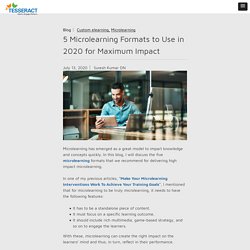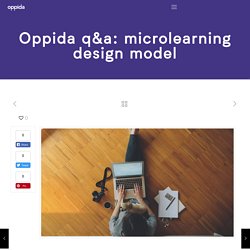

5 tips to make your microlearning strategy really deliver. The shift from “courses to resources” has been a hot topic for more than ten years.

Many learning designers chop up their content into bite-sized chunks. But is this more micro than learning? In this article, Kirstie Greany challenges traditional perceptions and shares some ideas on how to create a successful microlearning strategy. Microlearning: What is it? If you’re not sure what microlearning looks like, take a look at these 5 microlearning examples for inspiration. Others argue that shorter doesn’t equal better. At Elucidat, we feel that microlearning has more to offer than just being short.
Big or small learning chunks – does it matter? In a given day, whether I eat an entire cake (i.e., the course) or munch on five or six muffins (i.e., bite-sized chunks), what’s the difference in outcome? Just because something is shorter doesn’t mean it’s better for learning. Where microlearning can work Structure, spacing, personalization 1. 2. 3. 4. 5. Final thoughts Feeling inspired? 1. 2. 5 Microlearning Formats to Use in 2020 for Maximum Impact - Tesseract Learning. Microlearning has emerged as a great model to impart knowledge and concepts quickly.

In this blog, I will discuss the five microlearning formats that we recommend for delivering high impact microlearning. In one of my previous articles, “Make Your Microlearning Interventions Work To Achieve Your Training Goals”, I mentioned that for microlearning to be truly microlearning, it needs to have the following features: It has to be a standalone piece of content.It must focus on a specific learning outcome.It should include rich multimedia, game-based strategy, and so on to engage the learners. With these, microlearning can create the right impact on the learners’ mind and thus, in turn, reflect in their performance. In another article, “Creating An Effective Learning Experience Through Microlearning Strategy”, I mentioned that it is important to have clear goals that can be accomplished through microlearning. Some of the goals include, but are not limited to the following: 1. Q&a: microlearning design model. Interviewees: Bianca Raby, Founder/CEO, and Jay McGrane, K-12 Educator and Researcher Even though microlearning content started to become popular in 2017, there are still debates around what exactly constitutes microlearning.

The experts interviewed by the Elearning Guild for their Report on the State of Microlearning defined microlearning a few different ways: “Learning and support designed to fit into the employee’s life as much as possible.” — JD Dillon, Axonify“We’re talking about small things that take small amounts of time.” — Tanya Siedel, Artisan Elearning“A way that people at work fix, solve, and improve issues and situations at work.” — Ray Jimenez, Vignettes Learning“Searchability is key” — Roni Floman, GamEffective None of these experts specify a length, but the Association for Talent Development (ATD) found talent professionals define microlearning as modules between 2-15 minutes in length. The answer according to industry reports is definitely no: Bianca: Cost. Microlearning: What It Is and What It Isn't. Earlier this year, we published the results from our 2017 Learning and Remembering Survey.

In the survey, we asked respondents to tell us what learning trends or new training delivery methods they are most excited about for 2017. The number one answer? Microlearning. 18% of respondents said they’re excited about microlearning for the year ahead. The overall breakdown of trends cited lines up with the type of solutions we have been creating in recent months: Microlearning can take many different shapes. With that being said, just because people are excited about microlearning, doesn’t mean they know the proper way to incorporate it into their training strategy. The Myth of Microlearning. Numbers Don’t Lie: Why Bite-Sized Learning is Better for Your Learners (and You too)
Microlearning refers to an educational approach that offers bite-sized, small learning units with just the necessary amount of information to help learners achieve a goal.

In the eLearning and instructional design realm, its the latest buzzword. eLearning designers and developers discuss it when they meet around the water cooler. HR and training managers have found ways to implement it in their learning strategies. The top brass of companies is no longer questioning its efficacy. Day-long PowerPoint training sessions are passé; microlearning is an effective way to train adult corporate learners.
But being the prudent person that you are, you will want to see “the numbers” before you decide to board the bus. According to the Journal of Applied Psychology, learning in bite-sized pieces makes the transfer of learning from the classroom to the desk 17% more efficient. Also read: Is Bite-Size Learning the Way to Engage the Modern Distracted Learner? Millennial learners demand that training is. 5 Killer Examples: How To Use Microlearning-Based Training Effectively. Why Microlearning is HUGE and how to be a part of it. 8 Business Benefits Of Microlearning For Organizations.